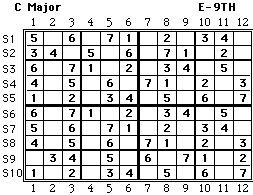| |
|
|
| |
The graphic below is a copy of a file that was drawn by an Excel spreadsheet
on a Macintosh computer. I first wrote this as a computer program for
an Apple IIc. The result is a chance to study the patterns that are
produced when we study a scale on our steel. The example is of an E-9th
guitar in the key of C. The spreadsheet gives you the choice of all
twelve keys and 53 different scales. It also will let you look at what
happens to the scale pattern when you push pedals and knee levers.
|
|
| |
|
|
| |
The scales begin at the first fret and continue up to fret twelve. You
should know that this pattern repeats every octave, so frets 13 thru fret
24, are the same as frets 1 thru 12. Knowing this, we can study the patterns
in one octave and know that the same thing is repeated, up the neck. |
|
| |
I use these scales to help study my guitar. The numbers represent the
scale tones of the particular scale that you are using. I do everything
in numbers which make changing keys much easier. |
|
| |
The scale tones that the numbers represent are from the major scale.
It is the same as singing do, re, mi, fa, so, la, ti, do. Looking at these
scale tones on a grid that represents your fretboard, allows you to see
the music on your guitar. |
|
| |
I broke the guitar into different sections to make it easier to study.
I even try to make up licks by jumping to a different section of the fretboard.
When I'm looking at one of these scale patterns, it allows me to see the
entire guitar. I don't have to think of the key of C as only the eighth
fret. I can see the entire guitar. The music is there, you have to go
and find it in all of the possible places that you can. If you see the
whole guitar, then you're more likely to develop the ability to play creatively.
All the instruments use the same scales, they just lay differently on
a pedal steel guitar. The stringed instruments all work the same when
it comes to the way scales make patterns. These scale pattern charts allow
you to study each tuning as a separate entity. They are similar, but the
patterns have subtle differences that the right and left hand must learn
to work together on. |
|
| |
 |
This shows the changes to the scale when the A pedal
bends 5 &10 a full step, and the B pedal pulls 3 & 6 a half-step.
With A & B pedals pressed the third fret lines up with a
major chord on your basic grips. |
|
|
| |
We all know that the E-9th set-up has certain pedals and knee levers
that are common to most guitars. We can use these standards to help
us study. If we consider the A pedal, which raises our 5th and 10th
strings a whole step, we can see places to utilize this change. The
tenth string has the same possibilities except the octave and thickness
of the string gives us a different characteristic of sound. If each
square is a half-tone, then we can move two squares up and get a new
note using the pedal. In other words, if we have the bar at the first
fret, string 5, we see that we have a scale tone of 1. (That's a C note)
We can use the pedal to bring a new note to the bar. Without moving
the bar, we can have the second scale tone (D note) brought to us at
the first fret.
|
|
| |
C scale intervals |
|
| |
- C = 1
- D = 2
- E = 3
- F = 4
- G = 5
- A = 6
- B = 7
|
You can go through all of your pedals and see what notes you
can bring to the bar. A knee lever that lowers a string goes the
opposite way to bring a note to the bar. The steel players left
hand thinks on a single plane. It depends on which fret you are
on. I use these scale patterns to play those fast single note
licks. You learn to connect the tones using pedals and slides.
|
|
|
| |
 |
This shows the changes to the scale when the A pedal
bends 5 &10 a full step, and the F lever pulls 4 & 8 a half-step.
Notice the major chord lining up at the 11th fret.
|
|
Remember, this is only one pattern. This pattern relates directly
to the white keys on a piano. All of the squares on the chart
that are empty would be equal to the black keys on the keyboard.
(That's a F# pentatonic). The keyboard has one place to find each
note, the steel has more than one place to find certain notes.
The C notes at F1,S5 and F8,S8 are the same except the sound is
different due to the difference in strings. With the computer
to assist us, we can study the steel like its never been before.
We can make up new tunings and study what pedals to use. To see
what I could come up with, I tuned a steel to minor-seventh-flat
five tuning. Then I added pedals that move strings half and whole
steps in various combinations. This allowed me to study the musical
aspect of where all the notes and chords would lie on the guitar.
Never needed to build a prototype to see that the possibilities
of the pedal steel are endless.
|
|
|





